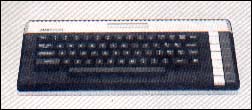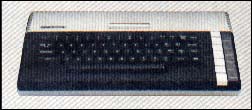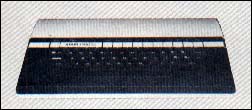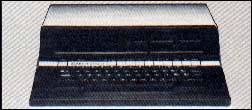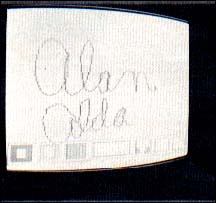Perspectives
Atari Transitions
Unless your power pack has wound down completely, you heard that Atari dropped 1700 hundred employees from their American manufacturing ranks. The rumor had been circulating for some time that the company would be doing business from an Oriental address.
The rest of the rumor is that the 2600 is already stockpiled in some noodle factory and that Atari is waiting to dump them onto the American market for $50 a piece.
The hang-up? Atari has to get its assemblyline to deliver two 5200s in a row to work.
The twelve million Atari 2600s currently in the market place seemed to auger well for the success of Atari's new keyboard interface. That is until the corporation scrapped the idea. Time, energy and financial resources went into the development and prototype production of Atari's add-on keyboard called the Graduate. The motive was to attract people to computing as cheaply as possible as well as take advantage of the large user-base of 2600's in the marketplace.
But Atari decided that it would be competing with itself, especially since the new 600XL is expected to enter the market discounted for less than $100.
The corporation felt so strongly about competing with its own Consumer Electronics Division, that it trashed the whole division along with the keyboard.
Bushnell Reaches Accord with Atari
Nolan Bushnell and Chuck E. Cheese of Pizza Time Theatre are sharing a slice with Atari, Inc.
Bushnell, founder of Atari and now chairman and chief executive officer of Pizza Time Theatre, licensed the consumer rights to his latest coin-operated video games to Atari. Bushnell will be developing the coin-ops through a subsidiary, Sente Technologies.
Bushnell was pushed out of Atari and the video games business shortly after Warner Communications acquired the Company in 1977. Bound by contract to stay away from the game field until after October, 1983, Bushnell got into trouble by announcing new video coin-op games that are going to set the industry on its microchips. Unfortunately, he made the announcement in April and Atari squawked that he reneged on his agreement.
Bushnell found himself in a lawsuit. But he's used to collecting in full from Warner. He settled the issue by granting them the home licensing rights to the forthcoming games. No value was placed on the licensing agreement, but Bushnell's last encounter with Warner scored him $15 million for the sale of his first company -- Atari.
No word on what kind of video game Sente will develop, but chance's are we will see increasing experiments with microchip controlled laser disks. Could mean a whole new kind of home video game hardware.
The Piggyback
Entex Industries loves Atari's latest decision. So does Spectravision. Both are makers of keyboard add-ons for the huge 2600 market.
With Atari's latest decision not to proceed with their introduction of the Graduate keyboard add-on, smaller competitors have the market to themselves.
Both keyboards attach to the 2600 through that machine's cassette port. The boards will even attach to a Coleco through their Atari interface device.
The 2000 Piggyback comes with 3K of Ram that is expandable to 19K. Its price, at this writing remains $125.
Will James Morgan Cure Atari Woes?
With the glut of new products in the micro-marketplace, there follows a glut of guts. Spilled, that is. And Atari is no exception.
With losses totalling hundreds of millions of dollars on quarterly earnings, Atari may start changing management like you and I change clothing. James J. Morgan, 41, a fellow who's done a great job peddling cigarettes for the domestic division of Philip Morris, Inc., has replaced Raymond E. Kassar as chairman and chief executive officer.
While we're willing to give Morgan every chance, the question is: Will he be able to market a product that hasn't been outlawed by the Surgeon General?
The mass market for home computers exploded last August when Texas Instruments, Inc. dropped the price of its basic 16K console to $150. Since then, hardware manufacturers have ridden some torturous paths, not to mention SEC plunges.
But there is a silver lining. With Atari writing off losses, like Pac-Man gobbles colored static, Morgan may be set up to right a lot of company wrongs. Many of Atari's write-offs -- $310 million in the last quarter -- consisted of inventory.
If that's true, look for even more bold price cutting and every dollar generated as a "profit" dollar next quarter,
Morgan, who is unfamiliar with personal computers says he'll bolster Atari's weak share of the education market.
Other antidotes to tailspinning profits include further consolidating of the home computer and video game business, revamping the line of home computers and eliminating mandates that the Atari line be handled exclusively by any given distributor.
If This Is You, Phone Home: You're A Wanted Child
Neighborhood reprisals against coin-op parlors and the spill-over to the video game phenomenon apparently have Atari worried. And why not, their coin-op division is not only responsible for a hefty profit on its own, but also the creative juices flowing there bear even greater fruit in the home video market.
A Minneapolis firm at Atari's behest profiled a typical coin-operated game player. Two thousand people, male and female, 10 to 45 were interviewed by Custom Research, Inc. They found the average video game player is a well-adjusted teenager, who's socially active, enjoys sports and maintains a "B" average or above.
Then the good news gets really catty. "Players," said the study, are likely to be involved in group activities and team sports, while "non-players" are interested in individual activities such as reading or sewing.
According to Atari the purpose of the study is to "shape future product development," but it appears just as likely that it was done to defend the idea of coin-op parlors and home video games against the growing accusation that they result in teenagers who can neither sew nor read!
West Coast Fever/Fervor
About every six months micro technology changes and that's about the time it took to get a Coke at the Eighth Annual West Coast Computer Faire. Nearly 47,000 persons jammed the escalators and packed the corridors at this once-a-year exhibition in that Mecca of microcomputing, San Francisco.
The annual fete brought together over 450 companies in the microcomputer field, who displayed their goods and services in 780 exhibitor booths. According to Jim Warren, the show's owner/impresario--a man who spends the whole three days of the convention on roller skates--the exhibitor space was sold out well in advance of the March 18 opening date. Fifty companies signed up on a waiting list for last minute space.
This year's exhibition blew the doors off of the Civic Auditorium. Booths stretched out to the loading ramp of Brooks Hall; they lined the corridors leading to the bathrooms and competed with lines around the refreshment stands.
Cash Programming Awards
A word to all those mothers in the audience: Dust off your seventeen-year-olds, they may be worth something yet.
David Beuhler of St. Paul, Minnesota proved it last January. The seventeen-year-old walked away with Atari's $25,000 grand prize for the best amateur freelance submission to the Atari Programmer's Exchange (APX).
David wrote something called Typo Attack, a program every budding young writer should own. The educational game improves your touch typing skills, while the player/typist takes satisfaction in repelling "animated typo invaders."
Since winning, David has had another program accepted by APX-a game called Impact.
SIG Sound-off
Some members of the popular Compuserve Atari Special Interest Group (SIG) sounded off to Atari President John Cavalier in an open letter.
In the letter, printed in the February issue of the Alamo Area Atari Users Association from San Antonio, TX, seventeen members of the SIG chastised Cavalier for Atari's slow follow-up of new products, the lack of simplicity in Atari's manuals, and Atari's perception of who they -- the SIG members -- are ("troublesome hackers").
They even score the company for their audibles at the line whereby the corporation changes direction. I'll quote: "Originally the direction was promotion of the Atari 800 as a business machine. Then as an educational machine. Now as a home computer."
No one at Hi-Res can remember a strong promotion of the 800 as a business machine, but we'll take their word for it.
The group's product wish list includes a double-density drive, a direct connect modem, firmware for a faster floating point routine, a better disk file management method and an improved tape drive.
The SIG members do give Atari the benefit of the doubt: "The market for personal computers has defined and redefined itself every six months." That can raise havoc with any corporation's strategy.
Louisville Sluggers and the Mental Health of Longbeach.
Antagonists, and protagonists came together in Louisville, Kentucky in a political, slugfest to argue the merits of video games and arcade amusements. The talks were held at a four-day National Recreation and Park Association Congress.
When the dust had settled the authorities decided that the games themselves are not hazardous to your health, but that the arcade parlor magnates and their teenage clientele need watching.
That was the opinion of both, Defenders and Dragons. Ronnie Lamm, a national spokesperson against the proliferation of video games, did not take issue with the games themselves, but with their locations.
"We're not talking about arcades... , she said, "'we're talking about the back rooms. . . We want them (the games) controlled in the community."
Ronnie has been working to establish video game controls in her home of Centereach, New York. Our best advice is to steer clear of Centereach backrooms--whatever their activity.
You may have to give a wide berth to Longbeach as well. That's where psychologist B. David Brooks is studying the social effects of video games on young people. Principal among his findings were some "kids who were spending their lunch money to and from school on games."
This sharp observation lost some of its sting, however, when he qualified it by saying that he also "found kids spending their lunch money to and from school in cigarette machines, candy store and other places, too."
Holy gym shorts!
This being the state of social and psychological research on the West Coast, Hi-Res can only hope none of its readers develops a serious mental problem in Longbeach.
Elastic Scholastic
Microzine sounds like a skin cream for minor burns, but it's actually an interactive computer magazine for kids.
Scholastic, Inc.--a household word in educational publications--is broadening its activity in the micro software and magazine market. At last January's Consumer Electronics Show, the company introduced its Wizware line of educational software--soon to be ready for the Atari--as well as their Microzine project.
If that isn't enough, Scholastic, founded in 1920, will launch its first consumer magazine. In what field? You bet! Family Computing is coming off the press in September to the tune of 400,000 copies, according to Scholastic's initial publicity piece.
The company first mixed into the software business by publishing a catalog of software available to educators. Avery Hunt the VP in charge of software development said that the catalog was a sort of "Seal of Approval" from Scholastic. They examined the package, and if they thought the program a good learning tool, they said so.
Their own line of Wizware educational software was a natural spin-off.
They expanded the idea of interactive programming to include their new Microzine.
As a former child and regular subscriber to The Weekly Reader, I called Steve Gass, formerly with Electronic Learning, another Scholastic publication for teachers, and now the project manager for Wizware and Microzine.
The bi-monthly Microzine will contain four different programs and a variety of interactive features.
"Ask Me," for example is a celebrity interview that the student conducts. He or she starts by selecting a "who is," "what are," or "did you" phrase. That sets up a menu listing ways to finish the question. A database gives the child a portion of the answer and the child has the option to ask for more information with another prompt. The celebrity can even ask the child a question.
Who's Scholastic's first celebrity interview? Robert McNaughton who played E.T.
The Microzine, available for the Atari and the Apple II+ is going to be peddled through retail stores for about 40 bucks a shot, an unusual move for a company who traditionally markets directly to school systems. But then, the micro industry is changing a lot of corporate habits.
Power-Plus Cartridges from CBS
CBS and their entry into the Atari software market is stale news, but their developments in the firmware industry bear watching. In-house VCS game developers soon encountered the walls and ceilings of the standard 2600 video game cartridge. Instead of trimming away the competitive beauty of the arcade bombshells that they've acquired -- Stomp-it, Blueprint, Solar Fox -- CBS developed its own chip to add some memory to the VCS cassettes -- the RAM and chip.
According to Marilyn Wolpin, the chip adds both RAM and ROM to the cartridge. Their first release on the new RAM+ chip will be a flight simulator called Wings. CBS guarantees that their Atari graphics presentation will leave George Plimpton catatonic.
Their flight simulator was so demanding that the brain trust at CBS thought that the Atari joystick needed some rethinking. The result is the new Power Play Booster Grip, a finger-form grip that fits over Atari's present offering and plugs into a second port. The stick offers not only a better "feel" but two extra switches to the player.
Next up for CBS Video Games is Charles Goren On Bridge. The heavy-hitter from the entertainment pages of hundreds of newspapers will lend his name to a line of programs that help you learn the game. Should have been done long ago: Congratulations to CBS.
Data Age Turns About-face On Licensing
Video games and their developers have come of age. Industry tradition has coin-op arcade game manufacturers developing hot new games and reaping residuals from the sales of pared down versions to the personal computer market and the VCS cartridge makers.
Data Age is sneaking into arcade palaces through the back door. Their Journey Escape game for the 2600 has been picked up by Bally/Midway for arcade consumption.
The cartridge game -- a so-so product by most reports ---capitalizes on the rock group journey's popularity among the teen set. Its success proves what Data Age has contended from its inception: that the smart money is on readily recognizable names and characters, redefined for the video game audience. With journey the rock group, Data Age found instant market recognition.
Data Age is trying the same thing with its Bermuda Triangle program, Frankenstein and Smokey the Bear -- all in the public domain. Add to this product line, Mr. Bill of Saturday Night Live fame, and Data Age comes in third after Mother and Apple Pie in terms of consumer identification.
CBS Poses Threat to Smaller Competitors
Watch for some price paring on CBS products through different distribution lines. CBS is emerging as a major contender for a market wedge in the lucrative software publishing industry. By swallowing up K-Byte Software last year, CBS's entry into the 400/800/1200 market was firmly established.
When Roklan developed the popular arcade game Gorf for 400/800 and then managed to store the essentials to a VCS cartridge for CBS, that company found a solid berth in the Atari 2600 market.
The latest from Art Barnett at CBS is that the company is changing its price structure to dealers and distributors. The net effect will be lower prices to consumers, "while maintaining or improving margins at all levels of distribution. We talked to Art Barnett, but he wouldn't say how much these prices were coming down. We don't know if CBS is talking about a $29.95 ROM program for the 800 or a $19.95 disk. So far, CBS has offered its programs only on ROM cartridges.
The announcement of the price cut said nothing about the VCS market. In any event, this is going to trigger some price-cutting among competitors.
Give Those "Compugirls" A Break
Women are slipping behind men in the race for computer literacy. That assertion lead to some more creative thinking by Sara Kiesler, a social scientist at Carnegie-Mellon University. She says that "the girls of today may find themselves second-class citizens in the computer-intensive world of tomorrow. (If this all sounds familiar, I recall outraged women speaking of themselves as traveling coach-fare through life when I was in college).
Even Hi-Res will agree that computing is male dominated; programs are male-designed and male marketed. There seems no more reason for this than the profit quest toward which males traditionally race.
That makes more sense to me than an article in Psychology Today that ran in March. Quoted in a recent issue of the "Orlando Sentinel by columnist Jeffrey Zaslow, he called Kiesler for some elaboration. The major stumbling block to women in computing seems to be social. According to Kiesler, "Men like their women to watch them play. And women try to fit the cultural roles expected of them."
This strikes Hi-Res as being archaic thinking and somewhat unreasonable.
On the hopeful side, no report that we have seen indicates any distinctions of ability based on sex while using or programming the computer. Females even seem to score just as well as males after practice on non-violent computer games.
The final and condescending conclusion of the scientists, which appeared in last March's Psychology Today, seems to eliminate the magazine as a barometer of contemporary intelligence. "Girls should not be discouraged by computing," the female and male scientists concluded, "Programming is more like following a recipe than fixing a bike."
Our conclusion: People who draw conclusions like the above, probably never dated much in college.
|
|
||||
|
|
New Products Assault from Atari at June's Summer Consumer Electronics Show
Atari, Inc. drew blood from competitors in the volatile battle for micro market supremacy, a war for micro dollars which is anything but tiny.
At an otherwise sluggish Summer Consumer Electronics Show held this june in Chicago, Atari, Inc. introduced a rash of new hardware products, a variety of software packages, a corporate name change, and tantalized onlookers with veiled talk of Ataritel, their new phone subsidiary. At the same time, Alan Alda turned up as Atari, Inc.'s new spokesperson.
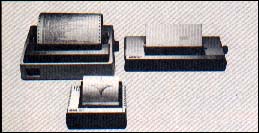
|
| Atari introduced their latest printer the letter quality 1027, as well as a forty-column thermal printer. |
The Atari Products Company, a new title for an amalgamation of old departments, under President John Cavalier, is responsible for the bulk of the Atari's new slimly designed, color-coordinated hardware add-ons. The company's four new computers, the 600XL, 800XL, 1400XL, and 1450XLD will supersede the 400 and current 800, while the fate of the 1200 has not been ascertained. The new computers borrowed their cabinet styling from the 1200, but, hopefully, will inherit none of the bad press that surrounds that machine. (Latest rumor is that the 1200 will disappear from the market to be re-tooled and re-appear as the 1400XL.)
All the new computers from Atari have standard keyboards and most are shipped with 64K standard and Atari Basic on cartridge. The exception is the 600XL, which is shipped with 16K, but is expandable to 64K.
The 1400 and 1450XLD feature built-in modems and speech synthesizers. In addition, the 1450 will be shipped with a dual-density, double-sided drive and the appropriate cabinet slot for adding a second unit.
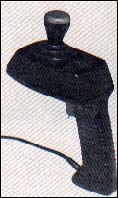
|
| Atari introduced its latest pistol-grip joystick for the 2600 game machine at June's Summer Consumer Electron- ics Show. |
The new drive will be supported this fall by DOS III, providing 127K per side of storage, in contrast to the 88K currently available from DOS II.
All of Atari's low-end models can be connected to an inexpensive direct connect modem. The 300 baud 1030 modem is not yet available. According to a Washington Post article, 100,000 modems are being made by Penril Corporation in Rockville, MD. The four million dollar order, the Post speculated, should mean that the consumer can own a 300 baud modem for less than $100.
More Peripheral Support
A barrage of peripherals for the Atari Home Computers will be released from now until the first quarter of next year. Most impressive will be Atari's 1027 printer, which will retail for $349.95 and features fully formed characters generated at 20 per second. The best news is that the printer will connect to any Atari Home Computer without the expansion interface.
The built-in voice synthesizers received a lukewarm reception at the Chicago show. The voice module on the 1400 and 1450 translates typed commands into a rough assimilation of phonetics known as English. Atari announced that "future programs" will be able to talk "to" the user.
In fact, quite a number of "future" products were announced that have to undergo some technical refinement before Atari can have them ready for the market. Atari's new trackball controller, a light pen, a graphics tablet, a Z-80 CP/M add-on for business software, and the 300 baud modem were all announced, but are not yet prepared for the market.
Technical Reception
Though the technical reviews are not in yet, it appears that Atari is in for the usual Hair Shirt Award from software developers and technologists alike. None of Atari's computers represented significant advances in state of the art microcomputing. Word is proliferating the technical "Old Boy" network that none of the machines are the technical equal of the former 800. The market truth is that the 800 cost too much to produce and in this microcomputing frontier, where, increasingly, manufacturers appear to be giving away hardware in order to ensure a market share in the future, Atari may have had no choice but to cut its most successful computer model.
|
|
The technically-minded in the audience will also bridle at the introduction of the long-awaited dual-density, double-sided disk that still only holds 254K of information. Furthermore, while the price of the new 1450 remained a mystery, the business computer does not appear to be the equal of the Tandy/Radio Shack Model IV with its two disk drives on board.
And, finally, a modem that transmits at 300 baud is not going to set the programming community on its collective rear.
Still, while technologists may find fault, the average consumer may welcome the comfortable line of matching products.
And there are bright spots. Atari's Expansion Box is certain to generate interest among consumers and technologists alike. The box allows all kinds of control cards, peripherals, and extra memory to be linked directly to the computer. The box contains eight expansion slots, two RS-232 ports, and a bi-directional parallel bus, which means parallel printers and drives may be added. Reliable report has it that one of the controller cards under development will be IBM-compatible.
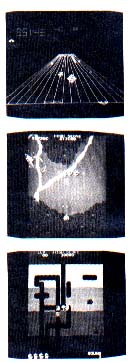
|
| Three of the many new Atari releases include Tempest and Xevious for the 5200 and Dig Dig which will be available for the 5200 and the 2600. |
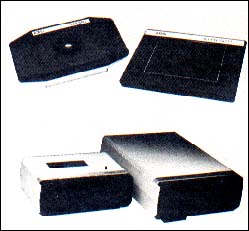
|
| The new Atari peripherals include a cassette, a dual den- sity disk drive, as well as a Trakball controller and Touch Tablet for graphics. |
Educators may be interested in Atari's new learning lab series, which will fit specially designed measuring devices and custom software to an Atari that will calibrate temperature, time, heartbeat, and even detect lies -- a package that may be more a source of anguish than amusement in the home or classroom. The first of the modules will be available in September for $89.95.
Software Additions
Twenty-eight new games were announced for the 2600 and the 5200, in both the entertainment and educational categories. The long awaited 16K Logo language cartridge and the Atariwriter cartridge led the list of introductions for the Atari Home Computers.
The Logo cartridge will be available in the fall and together with accompanying manuals will cost $99.95.
Atariwriter features automatic page numbering, global search and replace, a form letter option and control over placing headlines on the page. It also costs $100.
Jungle Hunt, Ms. Pac-Man, Dig Dug, Moon Patrol, and Battlezone coin-op hits are all coming up on the 5200 and the 2600. A license between Atari and Walt Disney will bring Donald Duck, Dumbo, and the Sorcerer's Apprentice to the 2600, while a license from Charles Schultz and the United Features Syndicate will bring Snoopy and the Red Baron to the video game arena. Atari has further licensed Miss Piggy from Henson Associates and Road Runner from Warner Brothers. The company will also develop a game based on the 1983 summer release from Columbia Pictures called Krull.
Overall, the market is in for some flattening this fall, if early reports from the floor of the Chicago show were correct. Software sales were down from what had been expected and, other than Atari, Inc., new product introductions were minimal. The exception was the Coleco Adam System of peripherals for its video game system. That system will battle for position with the "Graduate" and its peripherals for the Atari 2600 unit.
